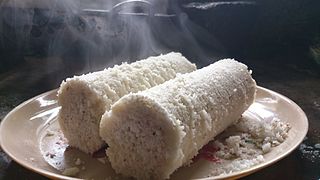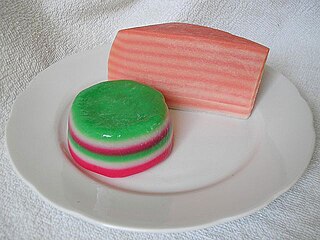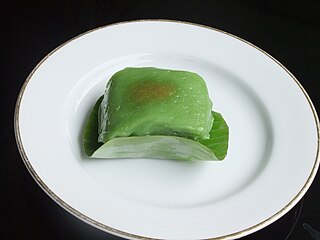
Kuih are bite-sized snack or dessert foods commonly found in Southeast Asia and China. It is a fairly broad term which may include items that would be called cakes, cookies, dumplings, pudding, biscuits, or pastries in English and are usually made from rice or glutinous rice. In China, where the term originates from, kueh or koé in the Min Nan languages refers to snacks which are typically made from rice but can occasionally be made from other grains such as wheat. The term kuih is widely used in Malaysia, Brunei, and Singapore, kueh is used in Singapore and Indonesia, kue is used in Indonesia only, all three refer to sweet or savoury desserts.

Idiyappam, also known as string hopper, indiappa, noolputtu, noolappam, or ottu shavige, is a string hopper dish originating from the Indian state of Kerala and Tamilnadu. It consists of rice flour pressed into noodles, laid into a flat disc-like shape and steamed. The dish also spread to Southeast Asia, where it is called putu mayam in Malaysia and Singapore, and putu mayang in Indonesia.

Puttu (Malayalam: പുട്ട്; Tamil: புட்டு;, alternatively spelled pittu, is a dish native to the South Indian states of Kerala, Tamil Nadu, and parts of Karnataka, as well as Eastern and Northern Provinces in Sri Lanka. Puttu means "portioned" in Tamil and Malayalam. It is made of steamed cylinders of ground rice layered with coconut shavings, sometimes with a sweet or savory filling on the inside. Puttu is usually a breakfast dish served hot with either sweet side dishes such as palm sugar or banana, or savoury with chana masala, chutney, rasam, or meat curries.

Appam is a type of thin pancake originating from South India. It is made with fermented rice batter and coconut milk, traditionally cooked in an appachatti, a deep pan similar in shape to a wok. It is part of Kerala and Tamil cuisine found in the Indian states of Tamil Nadu and Kerala and northern Sri Lanka. Appam are most frequently served for breakfast or dinner, often with a topping such as an egg.

A rice cake may be any kind of food item made from rice that has been shaped, condensed, or otherwise combined into a single object. A wide variety of rice cakes exist in many different cultures in which rice is eaten and are particularly prevalent in Japan. Common variations include cakes made with rice flour, those made from ground rice, and those made from whole grains of rice compressed together or combined with some other binding substance.

Kue is an Indonesian bite-sized snack or dessert food. Kue is a fairly broad term in Indonesian to describe a wide variety of snacks including cakes, cookies, fritters, pies, scones, and patisserie. Kue are made from a variety of ingredients in various forms; some are steamed, fried or baked. Kue are popular snacks in Indonesia, which has the largest variety of kue. Because of the countries' historical colonial ties, Koeé (kue) is also popular in the Netherlands.

Klepon, or kelepon, is a snack of sweet rice cake balls filled with molten palm sugar and coated in grated coconut. Of Javanese origin, the green-coloured glutinous rice balls are one of the popular traditional kue in Indonesian cuisine.

Kue putu or putu bambu is an Indonesian kue. It is made of rice flour called suji and coloured green with pandan leaves, filled with palm sugar, steamed in bamboo tubes, and served with desiccated coconut. This traditional bite-sized snack is commonly found in maritime Southeast Asia, particularly in Java, Indonesia, where it is called putu bumbung. Kue putu is usually sold by street vendors and can be found in traditional markets, along with other kues. Kue putu can also be found in the Netherlands due to its colonial ties with Indonesia.

Clorot, celorot, cerorot, or jelurut is an Indonesian traditional sweet snack made of sweet and soft rice flour cake with coconut milk, wrapped with janur or young coconut leaf in cone shape. It is a popular traditional sweet snack commonly found in Brunei, Indonesia, and Malaysia.

Kue lapis is an Indonesian kue, or a traditional snack of steamed colourful layered soft rice flour pudding. In Indonesian lapis means "layers". This steamed layered sticky rice cake or pudding is quite popular in Indonesia, Suriname and can also be found in the Netherlands through their colonial links. Kue lapis is also very popular in neighbouring Malaysia, Singapore, and Brunei where it is called kuih lapis. Kue lapis was introduced by the Sino-Burmese to Lower Myanmar, where it is known as kway lapay (ကွေလာပေး) or kway lapaysa (ကွေလာပေးစ).

Kue bugis is Indonesian kue or traditional snack of soft glutinous rice flour cake, filled with sweet grated coconut. The name is suggested to be related to Bugis ethnic group of South Sulawesi as their traditional delicacy, and it is originated from Makassar. In Java the almost identical kue is called kue mendut. Kue bugis, together with kue lapis and nagasari are among popular kue or Indonesian traditional sweet snacks, commonly found in Indonesian traditional marketplace as jajan pasar.

Bolu kukus is an Indonesian traditional snack of steamed sponge cupcake. The term "bolu kukus" however, usually refers to a type of kue mangkuk that is baked using mainly wheat flour with sugar, eggs, milk and soda, while also using common vanilla, chocolate, pandan or strawberry flavouring, acquired from food flavouring essence. The cake makes use of beaten eggs and soda as an emulsifier, the type of soda often being lemon sparkling water, such as Sprite.

Palembangese cuisine is the cuisine of the Palembangese people of the city of Palembang in the South Sumatra province of Indonesia. It is the second most well-known cuisine from Sumatra after Padang.

Kue pukis or simply called Pukis is an Indonesian kue or traditional snack made of a wheat flour-based batter and cooked in a special mold pan. It is a commonly found snack in Indonesian traditional markets.

Indian Indonesian cuisine is characterized by the mixture of Indian cuisine with local Indonesian-style. This cuisine consists of adaptations of authentic dishes from India, as well as original creations inspired by the diverse food culture of Indonesia. Indian influence can be observed in Indonesia as early as the 4th century. Following the spread of Islam to Indonesia and trading, Muslim Indian as well as Arab influences made their way into Indonesian cuisine. Examples include Indian biryani, murtabak, curry and paratha that influenced Acehnese, Minangkabau, Malay, Palembangese, Betawi and Javanese cuisine.

Kue talam is an Indonesian kue or traditional steamed snack made of a rice flour, coconut milk and other ingredients in a mold pan called talam which means "tray" in Indonesian. The cake mold used to create kue talam are either larger rectangular aluminium tray or smaller singular cups made from ceramics, aluminium, melamine or plastic.

Kue bangkit is a small biscuit that made from sago starch of Malay origin, commonly found in Indonesia and Malaysia. This biscuit has various colours, ranging from white, yellowish to brown, depends on the additional ingredients.

Kue bolu or simply Bolu is an Indonesian term to describes a wide variety of sponge cakes, tarts and cupcakes.




















